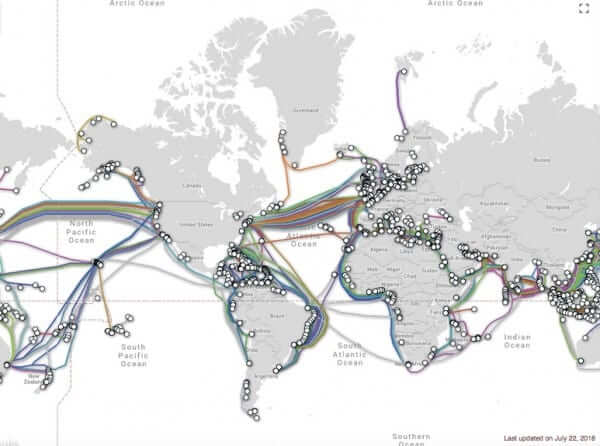
Computer scientists at the University of Wisconsin and the University of Oregon have determined that the United States’ Internet infrastructure is at serious risk of being flooded owing to the rising sea levels. According to Paul Barford (UW) and Ramakrishnan Durairajan (UO), this is because much of the land-based underground fiber optic cabling through which the Internet is carried is in shallow underground trenches along the coasts.
We find that 4,067 miles of fiber conduit will be under water and 1,101 nodes (e.g., points of presence and colocation centers) will be surrounded by water in the next 15 years.
In their recently published scientific paper, Lights Out: Climate Change Risk to Internet Infrastructure, Barford and Durairajan examine and explain just how very vulnerable the United States’ more than 4,000 miles of coastal Internet fiber is, estimating that much of it will be underwater in as few as 15 years, owing to the sea’s ever rising water level encroaching on and taking over coastal areas.
The very coastal areas within which these cables are buried in those shallow trenches.
Even the undersea Internet cables, which are generally waterproof (although not anchor proof and not safe from other sorts of risks) are vulnerable to failure at the points at which they connect to the land-based cables.
Barford explains that “the irony there is that those transoceanic cables have to come up above water at some point.”
The Internet Patrol is completely free, and reader-supported. Your tips via CashApp, Venmo, or Paypal are appreciated! Receipts will come from ISIPP.
Map of Undersea Internet Cables
Barford and Durairajan predict that by 2033, more than 4000 miles of underground fiber will no longer be underground so much as it will be underwater – and as it is not waterproof, digital chaos will ensue.
In the introduction to Lights Out: Climate Change Risk to Internet Infrastructure, Durairajan and Barford explain:
To understand and prepare for the impacts of climate change, a number of models have been developed to project average sea level rise. The models are based on a variety of empirical parameters including sea level rise over the past 100 years and the geographic features of coastal areas. The models predict significant incursions on coastal areas that imply displacement of large human populations. In response, some of the threatened areas are already preparing mitigation plans, but holding back the oceans is a formidable undertaking to say the least.
With significant sea level rise predicted, it is important to assess the threat to communication infrastructure. An indication of the potential impacts are the storm surges of major hurricanes such as Katrina and Sandy that devastated communication systems. While the standard buried fiber conduits are designed to be water and weather resistant, most of the deployed conduits are not designed to be under water permanently.
In this paper, we make a preliminary analysis of the risks of climate change on Internet infrastructure. The goal of our work is to understand risks and potential impacts over timescales of decades, which is consistent with other work on climate change. Our specific interest in this paper is assessing how the rise in sea levels threatens buried fiber conduits and termination points (e.g., colocation facilities, point of presences (POPs), etc.) in coastal areas in the US. Our analysis is conservative since it does not consider the threat of severe storms that would cause temporary sea level incursions beyond the predicted average. Our analysis also does not consider any efforts to harden or fortify communication infrastructure since we argue that this will only be feasible in relatively small geographic areas.
In making their predictions, the scientists took a map of the Internet system, and overlaid it with data from the National Oceanic and Atmospheric Administration (NOAA) predicting the worst-case projections of sea level rise.
Says Durairajan, upon noting that the results showed that the coastal areas of New York, Seattle, and Miami were among the areas predicted to be hardest hit, “When I actually saw the results, I was kind of horrified,” adding that “All of these locations are where my friends and family live.”
Barford and Durairajan conclude their paper by saying “We believe that these results highlight a real and present threat to the management and operations of communications systems and that steps should be taken soon to develop plans to address,” and while they don’t (yet) spell out the steps that they believe should be taken (perhaps that will be their next paper), they do say that “An important next step after a risk assessment such as ours is developing mitigation strategies. The strategies should be designed to minimize the impact of failures in coastal areas on inland infrastructure. One approach would be to consider how CIR (Continue Improvement in Return) metrics can be integrated into existing inter- and intra-domain routing substrate to create backup and alternative routes that reduce the impact of coastal infrastructure failures (e.g., related approach can be found in [25]). Another important strategy for mitigating climate change-related risks is to harden critical infrastructure in vulnerable areas. To this end, we believe that our analysis and expanded vulnerability analyses will provide a foundation for (i) frameworks to assess the impact of physical countermeasures such as seawalls and hardened enclosures for submarine cable landing points, (ii) mechanisms, protocols and systems to enable new methods for risk-aware and reliable routing, and (iii) policies for spectrum re-allocation so that first responders can communicate with minimum or no interruption.”
Footnote 25: Brian Eriksson, Ramakrishnan Durairajan, and Paul Barford. 2013. RiskRoute: A Framework for Mitigating Network Outage Threats. In ACM CoNEXT.
You can read the full text of “Lights Out: Climate Change Risk to Internet Infrastructure here.
So, how would you tackle this?
The Internet Patrol is completely free, and reader-supported. Your tips via CashApp, Venmo, or Paypal are appreciated! Receipts will come from ISIPP.










Looks like I won’t have to move to the west coast to have “ocean front property!”